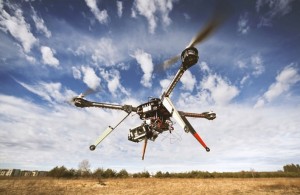Think There’s Nothing Humane about Drones? Think Again.

Last week, Women on Waves, a Dutch nonprofit that floats in international waters and provides abortion services to women in countries where legal constraints make abortions difficult or dangerous to obtain, announced the successful delivery of abortion pills from Germany to Poland by drone. The flight was completely legal in both countries because it was not in a controlled flight area, was not used for commercial purposes, and weighed less than five kilograms. The abortion pills were by prescription and were swallowed symbolically, in protest of Poland’s restrictive abortion laws, by non-pregnant Polish women from the group Feminoteka. Regardless, the German police confiscated the drone equipment and have announced their intent to press charges.
According to Agence France-Presse (AFP), the Catholic newspaper Nasz Dziennik described the planned drone delivery as a “drone of death,” which seems melodramatic when compared to the use of weaponized drones in countries like Pakistan, Yemen, Somalia, and Afghanistan. Indeed, “drone of death” might more appropriately encapsulate the psychological trauma experienced by civilians in a drone strike region. In 2013, a thirteen-year-old from Pakistan named Zubair Rehman testified before Congress and said: “I no longer love blue skies. In fact, I now prefer gray skies… The drones do not fly when the skies are gray… When the sky brightens, drones return and we live in fear. It’s something that a two-year-old would know… We hear the noise twenty-four hours a day.”
In addition to military use, drones have been in popular use for more than a decade, but we’re still not quite sure what to make of them, or how to govern them in a way that maintains the delicate balance between individual rights, privacy (at what height is a drone trespassing? What happens if your neighbor shoots it down with a shotgun?), and safety.
For example, if you’re not a fan of government surveillance and the power it implies, you might not be happy to know that US Customs and Border Protection (CBP) and some law enforcement agencies (last identified on a map in 2013 by Electronic Frontier Foundation) have flown “domestic drone missions” since 2004. A decade later, this past May, the US Justice Department published guidelines governing domestic drone usage in the interest of protecting First Amendment rights and privacy rights. The document states that agencies must have warrants “in circumstances in which a person has a reasonable expectation of privacy,” and it stipulates that drones can only be used in authorized investigations and activities if they are the “least intrusive means to accomplish an operational need.” Hopefully, these decrees will help to curb the use of drone technology for surveillance.
But drones can be used in so many more ways—by performance artists and photographers, filmmakers, and news channels. Attaching camera lenses to drones can be used to capture first person views from heights humans don’t normally have access to, providing us with new and exciting artistic perspectives. It’s what Robin McNicholas of The Guardian, in a recent think piece on drones, describes as “breaking down these geographical barriers.” Drones allow filmmakers to obtain shots that would normally be impossible or exorbitantly expensive to get and they can also facilitate new types of performance arts that incorporate drones into their show, for example the NSFW drone-shot pornographic film called “Drone Boning,” Cirque du Soleil’s Sparked or Disney’s Pixels in the Sky. Further, using drones for newsgathering may help keep journalists out of dangerous conditions or offer more intimate footage for the broadcaster’s audience.
Companies like Amazon have already patented the use of drones to deliver packages to customers around the world “in thirty minutes or less,” and are just waiting on the Federal Aviation Administration (FAA) to change regulations. A restaurant in Singapore even uses them to deliver meals to its patrons, citing the lack of a labour supply caused by the stigma towards service jobs. Google is also using drones, potentially to improve Google Earth and Google Map products, but also in deploying solar-powered drones that can hover in the air for long periods of time as a potential complement to Project Loon—in which they use high-altitude balloons to create a WiFi network with speeds up to 3Gs. This could potentially bring Internet access to millions who go without, and speaks to the lofty goals of complete globalization and international cooperation.
Drones are being used for gathering data on weather patterns and severe storms, extreme climates, topographies, volcanoes, and more. Researchers can study the qualities and formation of sea ice, jets of wind from the Antarctic, and nuclear sites like Chernobyl without being exposed to those elements. Drones can also gather biological data by following wildlife, or they can be used to catch poachers by monitoring national parks and nature reserves.
Farmers can also use commercial drones to gather crop intelligence. According to a Fortune article on agricultural drones in 2015: “For the first time agriculture drones will legally be able to gather widespread data across an entire growing season, allowing companies to test their business models and technologies together for the first time—and ideally make a profit in the process.” More importantly, gathering data on crop yields and trends will help international food security initiatives and give us insight on how to eradicate hunger.
With all these uses and applications, we must weigh the positive against the negative, the humane use of drones against the inhumane, and work to promote the former while discouraging the latter.
